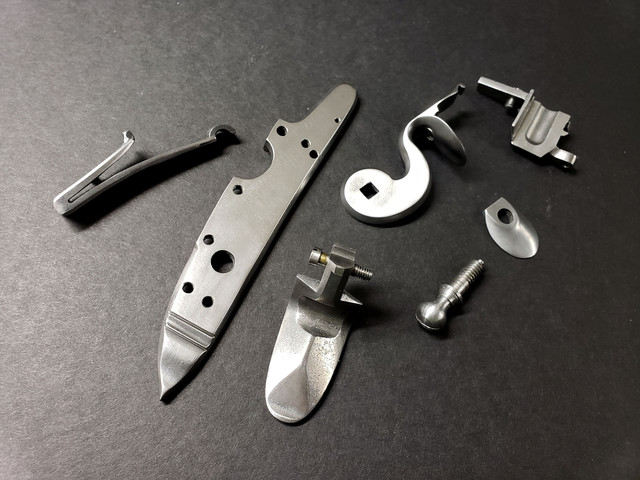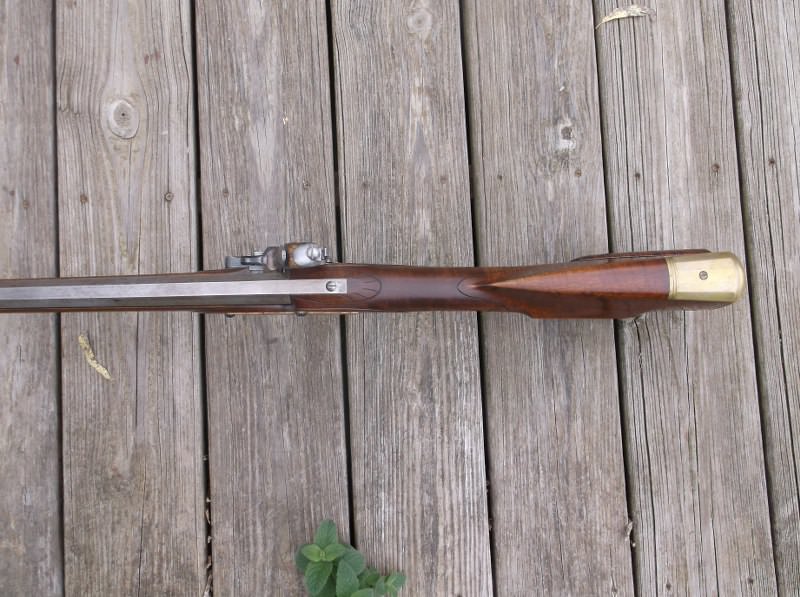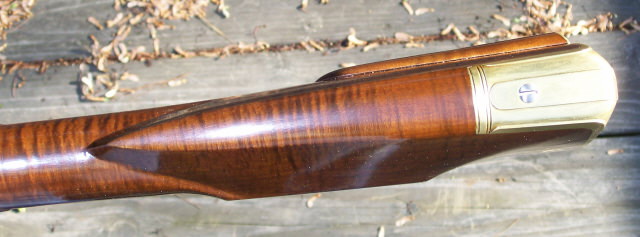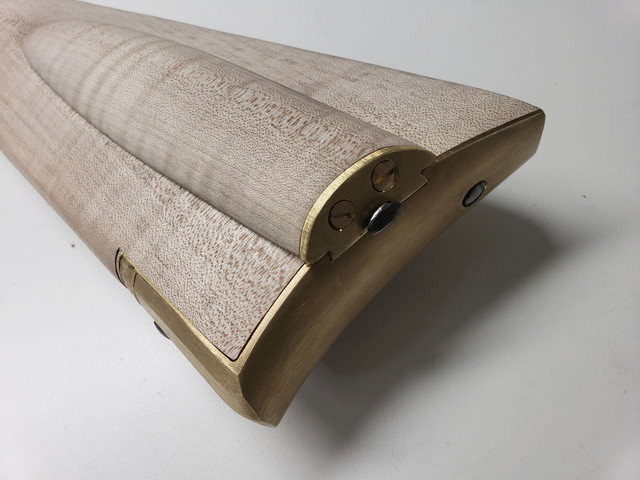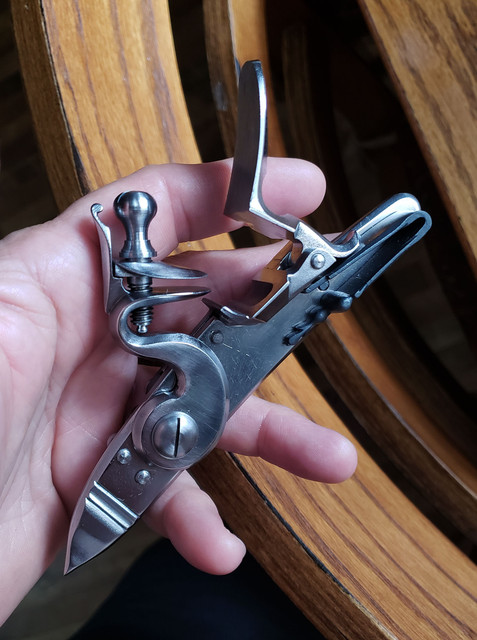-
Friends, our 2nd Amendment rights are always under attack and the NRA has been a constant for decades in helping fight that fight.
We have partnered with the NRA to offer you a discount on membership and Muzzleloading Forum gets a small percentage too of each membership, so you are supporting both the NRA and us.
Use this link to sign up please; https://membership.nra.org/recruiters/join/XR045103
You are using an out of date browser. It may not display this or other websites correctly.
You should upgrade or use an alternative browser.
You should upgrade or use an alternative browser.
Building 1st Gun_Isaac Haines
- Thread starter Jotto626
- Start date

Help Support Muzzleloading Forum:
This site may earn a commission from merchant affiliate
links, including eBay, Amazon, and others.
If they are nicely polished and oiled they don't tend to rust much. There isn't a place for moisture to hide, so to speak. That is another good reason to polish lock, BTW - they are a lot easier to clean without those little pits. After about 13 years my own lock, polished to about 400 grit IIRC, has stood up pretty well and is still shiny with a couple dark spots. I shoot it very seldom - once every couple years on average, sad to say - but I don't tend to re-oil between sessions either.
The originals were case hardened, which adds to the rust resistance, I think. I have an original Brown Bess lock plate that has seen a really rough life, rusted and pitted, but where the rust hasn't eaten through the original case-hardened surface it is very dark but almost glossy. I also have a German shotgun from c. 1840 that has a recycled 1750s or earlier lockplate, and it is a nice grey color with darker spots.
Edited to add: If are are talking about barrels, I'd just let a polished barrel take on a patina.
The originals were case hardened, which adds to the rust resistance, I think. I have an original Brown Bess lock plate that has seen a really rough life, rusted and pitted, but where the rust hasn't eaten through the original case-hardened surface it is very dark but almost glossy. I also have a German shotgun from c. 1840 that has a recycled 1750s or earlier lockplate, and it is a nice grey color with darker spots.
Edited to add: If are are talking about barrels, I'd just let a polished barrel take on a patina.
- Joined
- Nov 26, 2005
- Messages
- 5,211
- Reaction score
- 10,828
Hi,
Don't try and sand or file the hardened parts. Use stones and oil to smooth and finish. Polished steel does not rust quickly. Polished and hardened steel rusts even slower. A French gray finish was never used on American long rifles.
dave
Don't try and sand or file the hardened parts. Use stones and oil to smooth and finish. Polished steel does not rust quickly. Polished and hardened steel rusts even slower. A French gray finish was never used on American long rifles.
dave
Col. Batguano
75 Cal.
- Joined
- Feb 10, 2011
- Messages
- 5,038
- Reaction score
- 1,416
Why don't you deal with your frizzen the easy way? Soften the frizzen with heat treating, and then re-harden and temper it when you're done with what you're going to do to it.
- Joined
- Nov 26, 2005
- Messages
- 5,211
- Reaction score
- 10,828
Hi David,
Because if he does that the warranty from Chambers is void. Unless you know what you are doing, I would not do that. I do it all the time, but I know what I am doing.
dave
Because if he does that the warranty from Chambers is void. Unless you know what you are doing, I would not do that. I do it all the time, but I know what I am doing.
dave
Pete G
76 Cal.
Jotto626 said:To brown or not to brown.....I have also been reading about a French Gray finish. If I just do polished white, how do you keep it from rusting something terrible?
You definitely need to clean up all of the casting lines on your lock. The frizzen can be cleaned up with a diamond dust file or different grades of sharpening stones. I use phosphoric acid on locks to give an antique finish and a bit of rust resistance. You can find it at the hardware store sold as rust remover.
Why are you filing the frizzen? I just use a soft stone dunked in mineral spirits.For the parting lines I use a Dremel w/ a stone. I get rid of the blasted finish on the lock parts and then brown which "captures" the lube and prevents rust. Of course browning is rust and did you ever see "rust" get rusty?
Use 220 grit psper for the final finish on the lock parts...too shiny isn't good......Fred
Use 220 grit psper for the final finish on the lock parts...too shiny isn't good......Fred
Stophel
75 Cal.
- Joined
- Jul 8, 2005
- Messages
- 5,963
- Reaction score
- 869
Annealing and then rehardening/tempering the frizzen is definitely NOT the "easy" way, if you don't know what you're doing. (and even though I do know what I'm doing, I'd still definitely rather just stone the front of the frizzen off smooth!)
What is it that you don't like about your patchbox spring catch? By the way, it's something that you'll have to bend, shape, and fit to your gun. When you buy a patchbox latch, consider it a "blank". Although the "drive-in" front ends can be a pain, this type of latch works well, it's simple, and it is THE 18th century wood patchbox latch. You are simply not going to find any American rifle with a wood patch box with a push button latch (and you would be very hard pressed to find a German one that did.) Anything other than the ordinary type latch would stand out like a flashing red light.... and waving flags, and silver sprinkles...
Also, I have to say that your patchbox lid is still way too thick. Especially on such a slender gun. To bring the thickness down will likely require a new brass end, since you will cut into where your screw heads are. It needs to be fitted better to the surface of the buttplate too. :wink:
What is it that you don't like about your patchbox spring catch? By the way, it's something that you'll have to bend, shape, and fit to your gun. When you buy a patchbox latch, consider it a "blank". Although the "drive-in" front ends can be a pain, this type of latch works well, it's simple, and it is THE 18th century wood patchbox latch. You are simply not going to find any American rifle with a wood patch box with a push button latch (and you would be very hard pressed to find a German one that did.) Anything other than the ordinary type latch would stand out like a flashing red light.... and waving flags, and silver sprinkles...
Also, I have to say that your patchbox lid is still way too thick. Especially on such a slender gun. To bring the thickness down will likely require a new brass end, since you will cut into where your screw heads are. It needs to be fitted better to the surface of the buttplate too. :wink:
Have built 3 Chambers early Lasncaster kits but use his TGs and Bplates for both the Lancaster and Haines blank builds. A warning....the Haines TG if bent too much will break at the rear curl....anyways mine did. There's a void at that location, unless they corrected it.
Used both the Chambers Haines TG and Bplate for this build, but used the Dale Johnson lock.....Fred

Used both the Chambers Haines TG and Bplate for this build, but used the Dale Johnson lock.....Fred

I polished all my frizzens with sand paper wrapped around a needle file, it was easier than I thought it would be. I do buy the pink, expensive sandpaper from Lowe's, it cuts really well.
Similar threads
- Replies
- 6
- Views
- 313
- Replies
- 11
- Views
- 689
SOLD - Pending funds
.54 HAWKEN KIT $390 shipped!!
- Replies
- 22
- Views
- 1K




